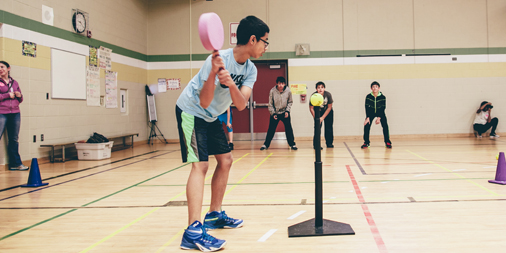
For over two decades, educators and student leaders across Ontario have used Raise the Bar resources for support in developing intramurals tailored to the unique needs of their school community; and it is our pleasure to share this Ophea platform with Steve Friesen, Raise the Bar Founder and Consultant. Steve is also a retired Health and Physical Education Teacher and currently a Recreation Leader with the City of Guelph. In connection with the upcoming full launch of Ophea’s Play for All: Strategies for Inclusive Intramurals resource, we asked Steve to reflect on his inspiring career and share his why when it comes to intramural programming. Take a trip with us back to 1998 and learn about how the Raise the Bar program started and the core values that still hold true today.
Years ago, I was asked by our two junior girls’ volleyball coaches to help them select their team. They had over 60 grade 9 and 10 girls interested, and I was happy to help them out. About ten days later, we had our team of 12 players. Many people were excited about the team and some even commented on how great it was that there was so much interest. However, it was different for me, and I couldn’t get the thought out of my head that we had just cut over 50 girls. Whatever great interest there was in girls’ volleyball at our school was quickly subdued with those cuts. I wasn’t proud of this and felt some responsibility for this situation.
I’m not entirely sure why I felt that way. I had been a varsity athlete in high school and university and making cuts was an accepted part of sport. I had also coached for years and was directly responsible for cutting kids from my teams.
At that time (1998), I had been reading articles on how kids were dropping out of sport – sound familiar? – and people were looking for solutions. I had recently become the Health and Physical Education and Athletics department head, and I was starting to look at things through a different lens – in a nutshell, I was recognizing the bigger picture.
Later that year the same scenario played itself out with the badminton teams and for me personally, I decided to make a change. We couldn’t offer multiple teams of the same sport but what we could do was offer a program that every student could participate in regardless of experience or skill. My solution was a lunchtime intramural program run by student leaders for the entire school. My definition of success was going to focus on how many students were playing.
We started in September by asking the students through a homeroom survey what sports/activities they wanted to play. We collated over 1,000 responses and started the year with indoor soccer. In a high school of 1,200 students, we had 350 students sign up for the first activity! The other activities that we offered were floor hockey, basketball, speedball (a combination of soccer, football, and basketball), table tennis and flickerball (a combination of football and basketball). The gym at lunch became ‘the’ place to be from September to June. The intramural program in its first year was the most impactful program in the school. The program continued to flourish and grow over the years adding new sports – many non-traditional – as well as adding a before school open gym program where students could come and shoot baskets before the first period. We included students with disabilities and had several staff members join teams as well. We had created a school culture where physical activity opportunities were available to every student. I was proud of that.
The intramural program never competed with the school athletics program – they worked together to provide opportunities for every student. Both programs shared the gym, the equipment and resources. My idea was that every student’s participation was of equal value and eventually we all agreed on that philosophy. As a Healthy and Physical Education department we saw intramurals as an extension of our teaching and always promoted the program in our classes.
Later in my career I transferred to a different school and in a matter of weeks we had an intramural program up and running with the support of student leaders and staff. The students were so excited, and the gymnasium was once again the most popular place in the school. For a Phys. Ed teacher, you couldn’t ask for more than that.
Ophea thanks Steve for sharing his voice and using this opportunity to reflect on his past teaching and coaching experiences, and for supporting our goal to re-imagine intramurals. Let’s keep the conversation going! Share with us what inclusive physical activity opportunities look, sound and feel like within your school community by tagging @OpheaCanada on Twitter, Facebook, and Instagram.
To stay up-to-date on Ophea professional learning offerings, resources, and supports, including the upcoming full launch of Ophea’s Play for All resource this Fall, sign up for Ophea’s e-newsletter, eConnection.
Ophea Publishing Note:
As of January 2024, the Raise the Bar website will be unavailable and Raise the Bar resources will no longer be offered for download in their current form. Much of the content will be adapted and included with the full launch of Play for All: Strategies for Inclusive Intramurals (explore the sneak peek launch of Play for All: Strategies for Inclusive Intramurals today!) but if there are any Raise the Bar resources that are integral parts of your practice, we encourage you to download them today!
Raise the Bar virtual workshops and consultations will be available until August 31, 2023. If your school community would benefit from a workshop after that date, please explore Ophea’s Professional Learning offerings, including Intramurals: Including Everyone in Physical Activity.
